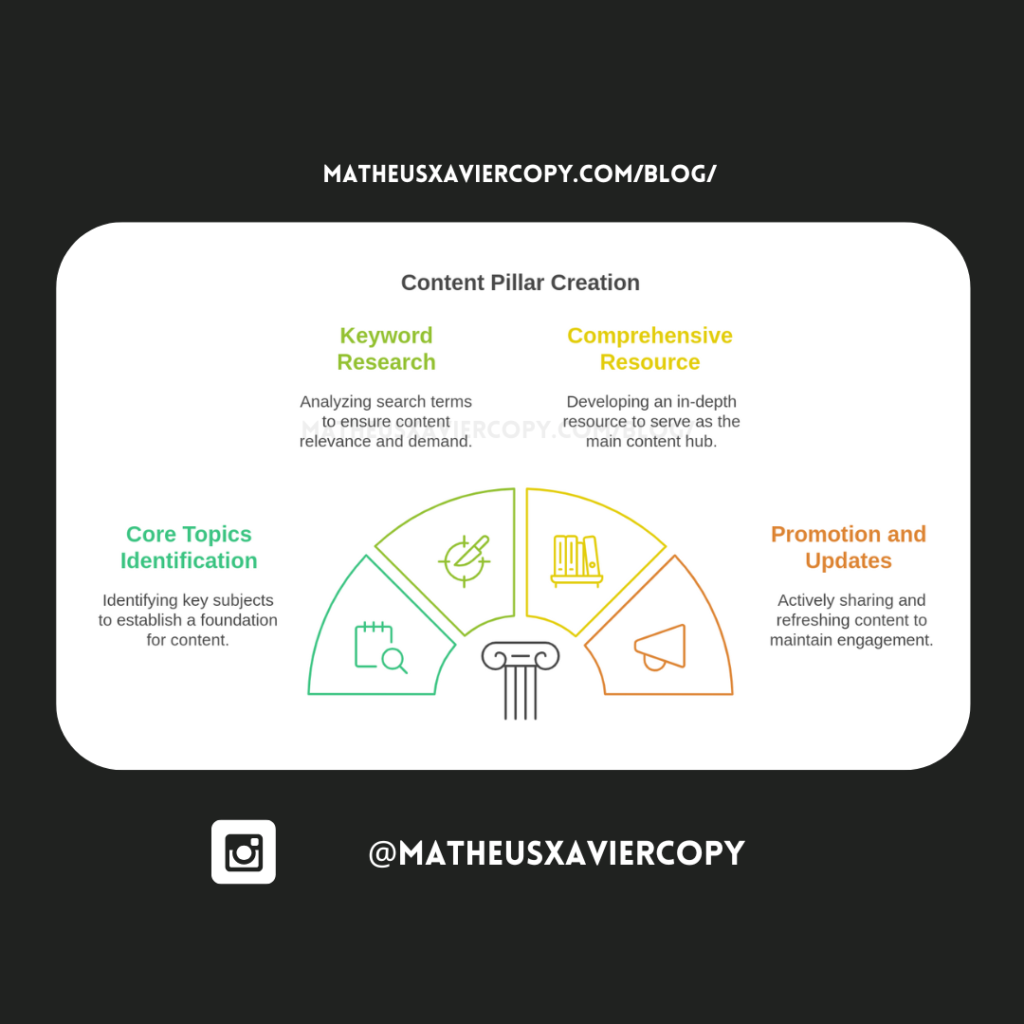Content pillar is one of the most important aspects of SEO. I will cover everything based on my experience in this 2024 guide for beginners.

If you’ve ever tried to create content—whether you’re a blogger, freelancer, or business owner—you’ve probably come across the term “content pillar.”
But what exactly does it mean, and why does it matter? Let me break it down for you in simple terms, using some real-life analogies that might make the whole thing clearer.
Trust me, once you understand the concept of content pillars, your content strategy will be a lot more solid and effective.
Content Pillar: Guide for Beginners 2024
Content Pillar: What Is It?
Content pillar is essentially a main topic or theme that holds up a broader content strategy. Think about it like the foundation of a house. Without a solid base, the entire structure will collapse. Content pillars do the same for your content—they support everything else.

For example, I have this guide for beginners about SEO where I reference other articles. So, if you read this article, you can see the main aspects of SEO, but you can also dive deeper into each aspect.
Imagine you’re playing a game of Mario. The level you’re trying to complete is like the topic you’re working on. And the blocks that Mario hits to collect coins or power-ups? Those are your individual blog posts, articles, or videos.
They’re smaller pieces of content that tie back to a bigger idea or theme. These main themes are your content pillars. For instance, let’s say you run a blog about digital marketing. Your content pillars could be topics like:
- SEO (Search Engine Optimization)
- Social Media Strategies
- Content Creation Tips
Each of these pillars could have subtopics (just like Mario collecting coins) such as “on-page SEO,” “content calendar creation,” or “Instagram marketing hacks.” They all connect to the broader theme of digital marketing, but they each serve a specific purpose.
Think of it like a big franchise such as Star Wars. It started with six movies, but to truly experience everything, you need to explore the live-action series, the animation, and the comics.
Your content pillar is like the movie that covers the big adventure and everything you need to know, while the spin-off content focuses on one specific topic at a deeper level. Check out my other content: A Guide for Beginners on Copywriting in 3 Steps.
Why Content Pillars Matter in 2024
Now, why does this matter in 2024? Well, let’s face it—people are overwhelmed with content. We’re all trying to find the next big thing, and the competition is fierce.

That’s where content pillars come in. They give structure to your content, making it easier for both search engines like Google and your audience to navigate through your site. Think of your website as a library. Without proper categorization, a library can be chaotic, right?
Now, imagine you walk into a library where all the books are organized into sections like “Fiction,” “History,” “Science,” and so on. That’s what content pillars do—they organize your content in a way that’s easy for both people and search engines to understand.
However, the content pillar is like your own library that contains only your books. Moreover, content pillars help you stay consistent. As a freelancer, I understand how challenging it can be to create content without a clear roadmap.
One minute, you’re writing about one thing, and the next, you’re jumping to something totally different. When you structure your content around pillars, it helps you stay focused and consistent.
This is crucial in 2024, when content marketing is all about providing value and not just creating endless posts for the sake of it.
If you want your content to be discoverable and valuable to your audience, create content pillars. This will keep everything aligned and help you build a solid content strategy.
4 Key Elements of the Content Pillar
Now that you understand that content pillars are crucial, let’s break down the four key elements that make up a successful content pillar:

Relevance
A content pillar needs to be relevant to both your audience and your business. It should address topics that your target audience cares about and actively searches for.
This is where keyword research comes into play. It’s similar to learning a new language, like Korean—you wouldn’t study random words but would focus on the most commonly used ones to be effective in the first few months.
Similarly, in content marketing, focus on keywords and topics that align with your audience’s needs. My advice is to concentrate on subjects that work for a broad audience; avoid being overly specific at this stage.
Comprehensiveness
A content pillar needs to be comprehensive. It’s the big picture, the overall map. For example, as I mentioned above, I have a content pillar about SEO.
It’s a broad subject that businesses, freelancers, bloggers, and many others want to learn about, making it highly relevant.
I then focus on explaining this subject in simple terms, guiding my readers to understand the key topics clearly. My advice is to start by considering these three main questions:
- What is?
- Why it’s important?
- How works?
For each concept I explain, I focus on these questions. For example, SEO is a set of techniques and strategies to increase the number of visitors to your website (What is it?).
If you have a lot of people visiting your website day after day, you can guide those visitors toward your personal or business goals (Why is it important?). The key elements are keywords, content, and HTML tags (How does it work?).
Internal Linking
This is one of the smartest ways to boost SEO. Once you’ve created your pillar, make sure your subtopics link back to it, and vice versa.
Basically, include links in your content pillar to articles about specific topics, and also link back to the content pillar from those specific topic articles. If you want more about why SEO is important, we have another article with 7 reasons why matters
Think of it like playing a game where you unlock new levels as you go. Internal linking is your way of guiding users to explore more of your content, just like Mario jumping between platforms to discover more secrets.
Scalability
Your content pillar should be scalable, meaning it can grow over time. As your business or blog evolves, so will your content. What I mean by this is that any specific topic you wrote about in the past can eventually become a content pillar itself.
After all, you can always dive deeper into a topic and make it increasingly specific. With this approach, you essentially have infinite content possibilities.
For example, keywords were just a topic in my SEO guide for beginners, but now I’ve created an entire piece dedicated to keyword research.
How to Create Your Content Pillar
So now that you know what content pillars are and why they matter, let’s dive into how you can actually create them. Here’s a step-by-step guide that will help you build your first content pillar (or improve the ones you already have).

Step 1: Identify Your Core Topics
First, take a moment to think about your business or website. What do you want to be known for? Always approach this as a beginner on the journey—someone who doesn’t yet know the basics but is asking the right questions and identifying the core topics.
My piece of advice is to literally search on Google about the subject you want to write about. Scroll down the page and check out the “People Also Ask” section.
At first, it will only show four topics, but click on the first one five times, and you’ll notice the list of topics will grow. Now, you have more ideas about the core topics to explore. How to make a headline? Learn Copywriting in 3 steps in this content!
Step 2: Keyword Research
Next, do your research. Use tools like Google Keyword Planner or Ahrefs to find high-traffic keywords related to your core topics. Click here to see my content about how to do keyword research, it’s a full guide in 3 steps!
This will help you refine the topics you’ve chosen and ensure there’s a demand for them. You don’t want to build a pillar around a topic that no one is searching for!
Step 3: Create a Comprehensive Resource
Now it’s time to build your pillar page. This should be an in-depth, all-encompassing page that covers your core topic in detail.
Think of it as the “main character” in a story. Then, start creating subtopics that dive deeper into specific aspects of that main idea. Don’t forget to link them back to your pillar.
Step 4: Promote and Update
Once your pillar content is live, promote it through social media, email marketing, or any other channel you use.
And don’t forget to update your content periodically. Think of it like running a marathon: your progress isn’t linear, and you’ll need to revise and improve as you go.
Did you like our content about the content pillar? Share it! And don’t forget to check out the brand-new articles we have on the blog to learn more and achieve the best results with your website.



























![How to make a headline? [Learn Copywriting in 3 steps]](https://matheusxaviercopy.com/wp-content/uploads/2024/11/Picsart_24-11-08_23-10-34-695-scaled.jpg)
![What is off-page SEO for website? [Understand in 1 minute]](https://matheusxaviercopy.com/wp-content/uploads/2024/11/Picsart_24-11-05_09-49-51-640-scaled.jpg)
![Content and SEO: Why do technology companies need it? [2024]](https://matheusxaviercopy.com/wp-content/uploads/2024/10/Picsart_24-10-15_17-25-02-236-scaled.jpg)


![SEO: What are the key elements? [Understand in 30 seconds]](https://matheusxaviercopy.com/wp-content/uploads/2024/10/Picsart_24-10-09_11-57-22-785-scaled.jpg)
![SEO: What is it in simple terms? [Understand in 30 seconds]](https://matheusxaviercopy.com/wp-content/uploads/2024/09/Picsart_24-09-10_11-16-03-082-scaled.jpg)


